Every year a new class of cardinals, that seems to be the tradition under Pope Francis. For this year, he calls in fourteen new members of the College, eleven of whom are able to vote in a conclave to elect his successor. This would bring the total number of electors up to 126, were it not for the ageing out of Cardinal Angelo Amato three weeks before the consistory, scheduled for 29 June. Still, the number of electors will be 5 above the maximum number established by soon-to-be Saint Paul VI, but, as noted before, this is a flexible rule that popes are free to break. Barring any deaths, the maximum number of 120 cardinal electors will again be reached by 31 July 2019.
The 2018 class of cardinals, as said, consists of 14 members from 11 different countries, all of which have had cardinals before. This may make the list less exotic than previous editions, although some of the new cardinals come from dioceses or curial departments which have never had red hats before.
Three of the new cardinals work in the curia, while the rest comes from dioceses (and one religious order) across the world. Three come from Italy, two from Spain, and one each from Iraq, Poland, Pakistan, Portugal, Peru, Madagascar, Japan, Mexico and Bolivia.
The list:
 Louis Raphael I Cardinal Sako, Cardinal-Bishop, Patriach of Babylon (Chaldean), Iraq. The second Patriarch of Babylon to be made a cardinal, and also the second Iraqi prelate. 69-year-old Patriarch Sako was appointed to Babylon and the leadership of the Chaldean Church in 2013. Before that he was the Metropolitan Archbishop of Kirkuk. As an eastern Patriarch, Cardinal Sako will automatically be a cardinal-bishop, but as a member of a non-Roman Catholic Church, albeit one in union with Rome, he will not be given a title church.
Louis Raphael I Cardinal Sako, Cardinal-Bishop, Patriach of Babylon (Chaldean), Iraq. The second Patriarch of Babylon to be made a cardinal, and also the second Iraqi prelate. 69-year-old Patriarch Sako was appointed to Babylon and the leadership of the Chaldean Church in 2013. Before that he was the Metropolitan Archbishop of Kirkuk. As an eastern Patriarch, Cardinal Sako will automatically be a cardinal-bishop, but as a member of a non-Roman Catholic Church, albeit one in union with Rome, he will not be given a title church.
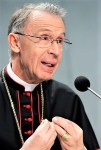 Luis Francisco Cardinal Ferrer, Cardinal-Deacon, Prefect of the Congregation for the Doctrine of the Faith. Ever since the popes ceased to head the chief office in the curia themselves, its prefects have been made cardinals. 74-year-old Spanish Jesuit Ladaria Ferrer, formerly the second in command under Cardinal Müller, receives the red hat a year after being made prefect.
Luis Francisco Cardinal Ferrer, Cardinal-Deacon, Prefect of the Congregation for the Doctrine of the Faith. Ever since the popes ceased to head the chief office in the curia themselves, its prefects have been made cardinals. 74-year-old Spanish Jesuit Ladaria Ferrer, formerly the second in command under Cardinal Müller, receives the red hat a year after being made prefect.
 Angelo Cardinal de Donatis, Cardinal-Priest, Vicar General of Rome. Another almost automatic red hat, even under Pope Francis, goes to the vicar general for the vicariate of Rome. The 64-year-old is the second cardinal in the Roman archdiocese, joining Cardinal Angelo Comastri, the vicar general for Vatican City.
Angelo Cardinal de Donatis, Cardinal-Priest, Vicar General of Rome. Another almost automatic red hat, even under Pope Francis, goes to the vicar general for the vicariate of Rome. The 64-year-old is the second cardinal in the Roman archdiocese, joining Cardinal Angelo Comastri, the vicar general for Vatican City.
 Giovanni Angelo Cardinal Becciu, Cardinal-Deacon, Substitute of the Secretariat of State. All of Cardinal-elect Becciu’s predecessors have been made cardinals, but none while serving as subsistutes in the Secretariat of State. The general expectation is that the 69-year-old Italian will also leave that office soon: he may well suceed Cardinal Angelo Amato, who will turn 80 in June, at the head of the Congregation for the Causes of Saints.
Giovanni Angelo Cardinal Becciu, Cardinal-Deacon, Substitute of the Secretariat of State. All of Cardinal-elect Becciu’s predecessors have been made cardinals, but none while serving as subsistutes in the Secretariat of State. The general expectation is that the 69-year-old Italian will also leave that office soon: he may well suceed Cardinal Angelo Amato, who will turn 80 in June, at the head of the Congregation for the Causes of Saints.
 Konrad Cardinal Krajewski, Cardinal-Deacon, Almoner of the Office of Papal Charities. Without doubt the highest-regarded curial official in Francis’ Rome, the 54-year-old Polish almoner runs the charitable initiatives on behalf of the pope in Rome. Under his responsibility, showers and barber facilities for homeless have been installed in the colonnades of St. Peter’s Square, to name but one example. Cardinal-elect Krajewski is the first papal almoner to be made a cardinal.
Konrad Cardinal Krajewski, Cardinal-Deacon, Almoner of the Office of Papal Charities. Without doubt the highest-regarded curial official in Francis’ Rome, the 54-year-old Polish almoner runs the charitable initiatives on behalf of the pope in Rome. Under his responsibility, showers and barber facilities for homeless have been installed in the colonnades of St. Peter’s Square, to name but one example. Cardinal-elect Krajewski is the first papal almoner to be made a cardinal.
 Joseph Cardinal Coutts, Cardinal-Priest, Archbishop of Karachi, Pakistan. The second Pakistani cardinal, and the first native of that country to receive the red hat, ever. Cardinal-elect Coutts, 72, has been in the country’s southern metropolis since 2012, following stints in the dioceses of Hyderabad and Faisalabad. His election must be seen in the first place as a sign of support for the small Catholic presence in a largely Muslim country.
Joseph Cardinal Coutts, Cardinal-Priest, Archbishop of Karachi, Pakistan. The second Pakistani cardinal, and the first native of that country to receive the red hat, ever. Cardinal-elect Coutts, 72, has been in the country’s southern metropolis since 2012, following stints in the dioceses of Hyderabad and Faisalabad. His election must be seen in the first place as a sign of support for the small Catholic presence in a largely Muslim country.
 António Augusto Cardinal dos Santos Marto, Cardinal-Priest, Bishop of Leiria-Fátima, Portugal. It is not the first time that Francis creates a cardinal in a country he has previously visited. The bishop of the diocese which includes the major Marian shrine of Portugal and beyond hosted the pope in May of 2017. The 71-year cardinal-elect also serves as vice-president of the Portuguese bishops’ conference and becomes that country’s second cardinal.
António Augusto Cardinal dos Santos Marto, Cardinal-Priest, Bishop of Leiria-Fátima, Portugal. It is not the first time that Francis creates a cardinal in a country he has previously visited. The bishop of the diocese which includes the major Marian shrine of Portugal and beyond hosted the pope in May of 2017. The 71-year cardinal-elect also serves as vice-president of the Portuguese bishops’ conference and becomes that country’s second cardinal.
 Pedro Ricardo Cardinal Barreto Jimeno, Cardinal-Priest, Archbishop of Huancayo, Peru. In January of this year, Pope Francis visited Peru, so that country also gets a cardinal. The 74-year-old archbishop of Huancayo joins the archbishop of the nation’s capital and is, like him, close to retirement. The cardinal-elect is the second Jesuit to be named in the current batch.
Pedro Ricardo Cardinal Barreto Jimeno, Cardinal-Priest, Archbishop of Huancayo, Peru. In January of this year, Pope Francis visited Peru, so that country also gets a cardinal. The 74-year-old archbishop of Huancayo joins the archbishop of the nation’s capital and is, like him, close to retirement. The cardinal-elect is the second Jesuit to be named in the current batch.
 Désiré Cardinal Tsarahazana, Cardinal-Priest, Archbishop of Toamasina, Madagascar. After eight years, Madagascar gets a cardinal again, although he is not the archbishop of the capital, Antananarivo. Instead, tnhe 63-year-old cardinal-designate comes from the coastal see of Toamasina. He is the first archbishop of that see, after is was raised to that status in 2010, and he also serves as president of the Malagassy bishops’ conference.
Désiré Cardinal Tsarahazana, Cardinal-Priest, Archbishop of Toamasina, Madagascar. After eight years, Madagascar gets a cardinal again, although he is not the archbishop of the capital, Antananarivo. Instead, tnhe 63-year-old cardinal-designate comes from the coastal see of Toamasina. He is the first archbishop of that see, after is was raised to that status in 2010, and he also serves as president of the Malagassy bishops’ conference.

Giuseppe Cardinal Petrocchi, Cardinal-Priest, Archbishop of L’Aquila, Italy. In Italy’s mountaineous and earthquake-stricken region of L’Aquila since 2013, the 69-year-old cardinal-elect has been unavoidably involved with missions of charity and works of mercy. The first cardinal from that see, the appointment once more overlooks such ‘autmoatic’ cardinalatial sees like Venice, Turin and Milan.
 Thomas Aquino Manyo Cardinal Maeda, Cardinal-Priest, Archbishop of Osaka, Japan. Japan was long overdue for a cardinal, and this appointment as not as unique as may be expected. Previous Japanese cardinals came from Tokyo twice, but also one time each from Nagasaki and Osaka. The appointment of the 69-year-old archbishop, who has been in office since 2014, is once more a sign of support for a small Asian Catholic congregation.
Thomas Aquino Manyo Cardinal Maeda, Cardinal-Priest, Archbishop of Osaka, Japan. Japan was long overdue for a cardinal, and this appointment as not as unique as may be expected. Previous Japanese cardinals came from Tokyo twice, but also one time each from Nagasaki and Osaka. The appointment of the 69-year-old archbishop, who has been in office since 2014, is once more a sign of support for a small Asian Catholic congregation.
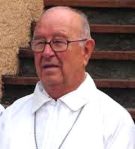 Sergio Cardinal Obeso Rivera, Cardinal-Priest, Archbishop emeritus of Jalapa, Mexico. There’s always a Mexican among Francis’ appointments, it seems, but this time the choice has fallen on an archbishop who has retired since 2007. The 86-year-old’s election is one of honour, then, perhaps in part because of his two presidencies of the Mexican bishops’ conference.
Sergio Cardinal Obeso Rivera, Cardinal-Priest, Archbishop emeritus of Jalapa, Mexico. There’s always a Mexican among Francis’ appointments, it seems, but this time the choice has fallen on an archbishop who has retired since 2007. The 86-year-old’s election is one of honour, then, perhaps in part because of his two presidencies of the Mexican bishops’ conference.
 Toribio Cardinal Ticona Porco, Cardinal-Priest, Prelate emeritus of Corocoro, Bolivia. The 81-year-old retired prelate of a small mountain mining town could be said to have truly served on the fringes of the Catholic Church. The economy in the area has been stagnant since 1985, and the new cardinal has worked here for 20 years. He is the third Bolivian cardinal and the first not to come from one of the nation’s two capitals.
Toribio Cardinal Ticona Porco, Cardinal-Priest, Prelate emeritus of Corocoro, Bolivia. The 81-year-old retired prelate of a small mountain mining town could be said to have truly served on the fringes of the Catholic Church. The economy in the area has been stagnant since 1985, and the new cardinal has worked here for 20 years. He is the third Bolivian cardinal and the first not to come from one of the nation’s two capitals.
 Aquilino Cardinal Bocos Merino, Cardinal-Deacon, Superior General emeritus of the Missionary Sons of the Immaculate Heart of Mary. Pope Francis places great value and emphasis on religious life, so in that sense it is odd that he names only three religious cardinals this time around. Perhaps he tries to balance that with the appointment of the 80-year-old Spanish Claretian who headed his order from 1991 to 2003. The order has produced four other cardinals, two of whom are still alive. It is f
Aquilino Cardinal Bocos Merino, Cardinal-Deacon, Superior General emeritus of the Missionary Sons of the Immaculate Heart of Mary. Pope Francis places great value and emphasis on religious life, so in that sense it is odd that he names only three religious cardinals this time around. Perhaps he tries to balance that with the appointment of the 80-year-old Spanish Claretian who headed his order from 1991 to 2003. The order has produced four other cardinals, two of whom are still alive. It is f
By the time of the consistory, Pope Francis will have created almost half of the electors, or active members of the College of Cardinals. He will have created 59 of them, while 47 will have been created by Pope emeritus Benedict XVI and a further 19 by Pope Saint John Paul II.
With the new consistory, Italy remains over-represented in the College, with 22 electors. It is followed by the United States with 10, Spain, France and Pland with 5, and Mexico, Brazil and India with 4 electors each. All other countries are represented by 2 or less cardinal electors.
Other changes
Before yesterdays’ announcement of the upcoming consistory, another change took place in the College of Cardinals, albeit an expected one. Ten years after being created, a cardinal-deacon can opt to be elevated to the next rank of cardinal-priest. This changes nothing in their hands, but only in their precedence among the other cardinals and thus their duties at a conclave to elect a new pope.
All six cardinal-deacons who were created by Pope Benedict XVI in 2007 accepted this change and became cardinal-priests, thus joining the other 11 surviving cardinal of their consistory, rising in precedence from after the most recently-created cardinal-priests of Pope Francis, to roughly the middle section of the cardinal-priests.
These six cardinals, who all kept their title churches pro hac vice (“for this time”, ie. for the duration of their being cardinals, which is usually until death) are:
- Leonardo Cardinal Sandri, Prefect of the Congregation for Oriental Churches and Grand Chancellor of the Pontifical Oriental Institute
- Paul Josef Cardinal Cordes, President emeritus of the Pontifical Council “Cor Unum”
- Angelo Cardinal Comastri, President of the Fabric of St. Peter, Archpriest of St. Peter’s Basilica and Vicar General for the Vatican City State
- Raffaele Cardinal Farina, Archivist emeritus of the Vatican Secret Archives, Librarian emeritus of the Vatican Apostolic Library and President emeritus of the Pontifical Commission for Reference on the Institute for Works of Religion
- Giovanni Cardinal Lajolo, President emeritus of the Pontifical Commission for the Vatican City State and President of the Governorate of the Vatican City State
- Stanislaw Cardinal Rylko, Archpriest of the Papal Basilica of St. Mary Major
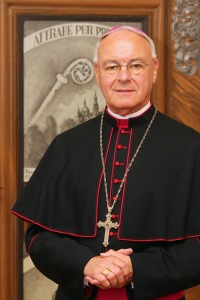 The retirement and appointment of bishops is pretty easy to predict, as bishops are legally bound to offer their resignation when they reach the age of 75. Locally, there are currently three dioceses without a bishop: Roermond in the Netherlands, and Hildesheim and Würzburg in Germany. In 2018, two more will likely join these: in Fulda, Bishop Heinz Josef Algermissen (at right) will celebrate his 75th on 15 February, and in Namur, Bishop Remy Vancottem will do likewise on 25 July. A third likely diocese to fall vacant in Ghent. Bishop Luc van Looy will turn 77 on 28 September. Upon his 75th birthday, the diocese made it known that Pope Francis had requested the bishop stay on for two more years, and that extension is up this year.
The retirement and appointment of bishops is pretty easy to predict, as bishops are legally bound to offer their resignation when they reach the age of 75. Locally, there are currently three dioceses without a bishop: Roermond in the Netherlands, and Hildesheim and Würzburg in Germany. In 2018, two more will likely join these: in Fulda, Bishop Heinz Josef Algermissen (at right) will celebrate his 75th on 15 February, and in Namur, Bishop Remy Vancottem will do likewise on 25 July. A third likely diocese to fall vacant in Ghent. Bishop Luc van Looy will turn 77 on 28 September. Upon his 75th birthday, the diocese made it known that Pope Francis had requested the bishop stay on for two more years, and that extension is up this year.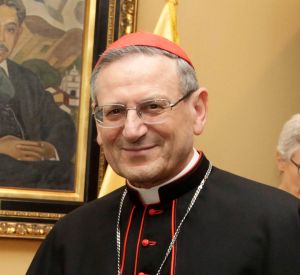 While all hold memberships in various dicasteries in the curia, two of these sit at the head of them: Cardinal Coccopalmerio is president of the Pontifical Council for Legislative Texts and Cardinal Amato (at left) is the prefect of the Congregation for the Causes of Saints. Cardinal Nguyễn Văn Nhơn remains active as archbishop of Hanoi. All will undoubtedly retire upon their 80th birthday, opening up some interesting positions in the curia. Barring any deaths, the number of cardinal electors will stand at 114 by mid-2018. Possibly not low enough for a new consistory by itself, but considering the fact that a further 10 ill age out in 2019, Pope Francis may decide to be proactive and call a consistory in autumn for the creation of anywhere between 6 and 16 new cardinals.
While all hold memberships in various dicasteries in the curia, two of these sit at the head of them: Cardinal Coccopalmerio is president of the Pontifical Council for Legislative Texts and Cardinal Amato (at left) is the prefect of the Congregation for the Causes of Saints. Cardinal Nguyễn Văn Nhơn remains active as archbishop of Hanoi. All will undoubtedly retire upon their 80th birthday, opening up some interesting positions in the curia. Barring any deaths, the number of cardinal electors will stand at 114 by mid-2018. Possibly not low enough for a new consistory by itself, but considering the fact that a further 10 ill age out in 2019, Pope Francis may decide to be proactive and call a consistory in autumn for the creation of anywhere between 6 and 16 new cardinals.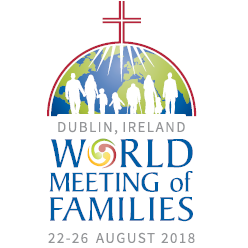 Speaking about the pope, he will, despite the fact that he has no love for travelling, visit several countries in 2018. In January, he will once again return to South America, visiting Peru and Chile. Ireland is on the schedule in August, when the Holy Father will attend the World Meeting of Families taking place in Dublin (logo at right). Visits not yet confirmed are to the Baltic countries in September and to Romania in December. A visit to India also remains an option, but as Pope Francis has just wrapped a visit to India’s neighbouring countries of Myanmar and Bangladesh, it may not be at the top of the list.
Speaking about the pope, he will, despite the fact that he has no love for travelling, visit several countries in 2018. In January, he will once again return to South America, visiting Peru and Chile. Ireland is on the schedule in August, when the Holy Father will attend the World Meeting of Families taking place in Dublin (logo at right). Visits not yet confirmed are to the Baltic countries in September and to Romania in December. A visit to India also remains an option, but as Pope Francis has just wrapped a visit to India’s neighbouring countries of Myanmar and Bangladesh, it may not be at the top of the list.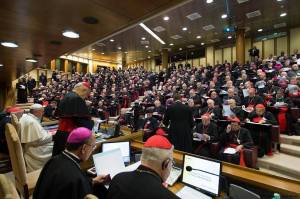 In the latter part of the year, all eyes will be on the Synod of Bishops again, this while the reverberations of the last two assemblies of that body are still being felt. The October 2018 Fifteenth Ordinary General Assembly of the Synod of Bishops while focus on “Young People, Faith and Vocational Discernment”. To this assembly, each bishops’ conference will elect one or more (depending on their size) delegates, while the Pope will also make a personal selection of delegates. One of these personal choices has already been made: Sérgio Cardinal Da Rocha, the archbishop of Brasília, was appointed as Relator General of next year’s assembly. He will outline the theme at the start of the assembly and summarise the delegates’ speeches so they can be condensed into concrete proposals.
In the latter part of the year, all eyes will be on the Synod of Bishops again, this while the reverberations of the last two assemblies of that body are still being felt. The October 2018 Fifteenth Ordinary General Assembly of the Synod of Bishops while focus on “Young People, Faith and Vocational Discernment”. To this assembly, each bishops’ conference will elect one or more (depending on their size) delegates, while the Pope will also make a personal selection of delegates. One of these personal choices has already been made: Sérgio Cardinal Da Rocha, the archbishop of Brasília, was appointed as Relator General of next year’s assembly. He will outline the theme at the start of the assembly and summarise the delegates’ speeches so they can be condensed into concrete proposals. The Holy See today announced that Pope Francis will create his second group of cardinals in a consistory on 14 February. As his first consistory included plenty of surprising choices, it can be safely assumed that the second will be no different. But perhaps we may make some guesses at who will be among the new princes of the Church.
The Holy See today announced that Pope Francis will create his second group of cardinals in a consistory on 14 February. As his first consistory included plenty of surprising choices, it can be safely assumed that the second will be no different. But perhaps we may make some guesses at who will be among the new princes of the Church.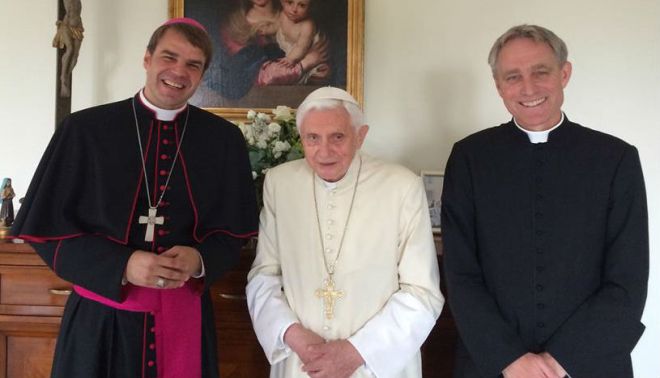

 Yesterday the Holy See published the list of participants in the upcoming Synod of Bishops on the family. Of course, there are the usual suspects: the heads of the Roman Curia departments, the standing members of the Synod and the presidents of the world’s bishops’ conferences, with the latter being default participants in an Extraordinary General Synod, which this one is. Pope Francis has had a personal touch in the selection of several participants; noteable among those are Cardinal Kasper, to all appearances a theologian much appreciated by the Holy Father, but also the vast majority of cardinals he created in his first consistory of last February.
Yesterday the Holy See published the list of participants in the upcoming Synod of Bishops on the family. Of course, there are the usual suspects: the heads of the Roman Curia departments, the standing members of the Synod and the presidents of the world’s bishops’ conferences, with the latter being default participants in an Extraordinary General Synod, which this one is. Pope Francis has had a personal touch in the selection of several participants; noteable among those are Cardinal Kasper, to all appearances a theologian much appreciated by the Holy Father, but also the vast majority of cardinals he created in his first consistory of last February. From a local point of view it is interesting to see that no less than four participants come from Belgium, while there is only a single one from the Netherlands and a mere two from Germany. Belgium sends Archbishop André-Joseph Léonard,which was expected as he is the president of the Belgian bishops’ conference, but also his predecessor, Cardinal Godfried Danneels (pictured), as well as Father George Henri Ruyssen of the Pontifical Oriental Institute in Rome. Additionaly, Metropolitan Athenagoras, the head of the Russian Orthodox Church in Belgium, attends as a “fraternal delegate”.
From a local point of view it is interesting to see that no less than four participants come from Belgium, while there is only a single one from the Netherlands and a mere two from Germany. Belgium sends Archbishop André-Joseph Léonard,which was expected as he is the president of the Belgian bishops’ conference, but also his predecessor, Cardinal Godfried Danneels (pictured), as well as Father George Henri Ruyssen of the Pontifical Oriental Institute in Rome. Additionaly, Metropolitan Athenagoras, the head of the Russian Orthodox Church in Belgium, attends as a “fraternal delegate”. In the afternoon, after a lunch and cappuccino break (at left), Cardinal Angelo Amato received the bishops at the Congregation for the Causes of the Saints (pictured below), a meeting with some consequences for current Dutch causes. Top of the list were the martyrs of Alkmaar, murdered for the faith in 1572, and Fr. Johannes Roothaan, the second founder of the Jesuit Order. Both causes were dormant for decades, but may now become active again.
In the afternoon, after a lunch and cappuccino break (at left), Cardinal Angelo Amato received the bishops at the Congregation for the Causes of the Saints (pictured below), a meeting with some consequences for current Dutch causes. Top of the list were the martyrs of Alkmaar, murdered for the faith in 1572, and Fr. Johannes Roothaan, the second founder of the Jesuit Order. Both causes were dormant for decades, but may now become active again.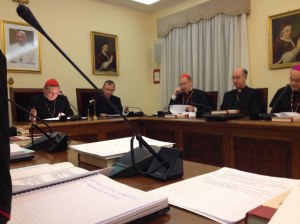 Bishop Frans Wiertz presented Dutch-born Bishop Frans Schraven as a possible patron saint for victims of sexual abuse. The case of Bishop Schraven, killed in China by Japanese soldiers in 1931 for not submitting the women and girls under his protection to be used as sex slaves, was opened earlier this year.
Bishop Frans Wiertz presented Dutch-born Bishop Frans Schraven as a possible patron saint for victims of sexual abuse. The case of Bishop Schraven, killed in China by Japanese soldiers in 1931 for not submitting the women and girls under his protection to be used as sex slaves, was opened earlier this year.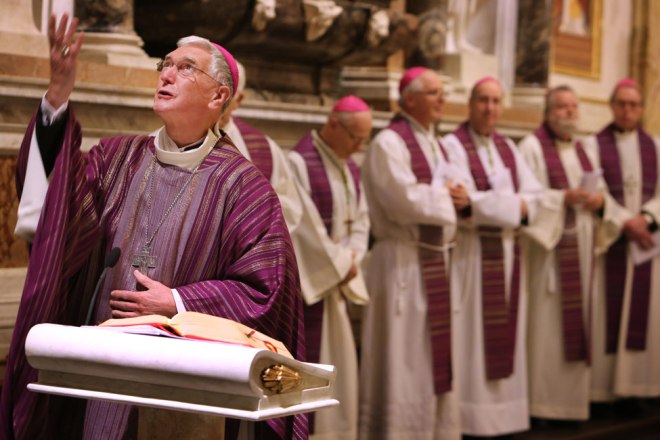


 On 12 June a day of prayer in honour of the Lady of All Nations will take place in Amsterdam, under the auspices and with the participation of Bishop Jos Punt of the Diocese of Haarlem-Amsterdam. Lady of All Nations refers to the Blessed Virgin and specifically the alleged apparitions of her in Amsterdam between 1945 and 1959. These apparitions, like others across the world, caused much debate and also much enthusiasm. The debate still remains, and is fueled by a distinct lack of clarity.
On 12 June a day of prayer in honour of the Lady of All Nations will take place in Amsterdam, under the auspices and with the participation of Bishop Jos Punt of the Diocese of Haarlem-Amsterdam. Lady of All Nations refers to the Blessed Virgin and specifically the alleged apparitions of her in Amsterdam between 1945 and 1959. These apparitions, like others across the world, caused much debate and also much enthusiasm. The debate still remains, and is fueled by a distinct lack of clarity.